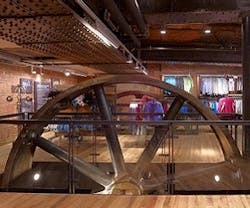Storytelling through Materials
I recently had a conversation with Michael Gaffney, senior associate vice president at CallisonRTKL in Seattle, about the importance of re-using existing building materials and furnishings in renovation projects. During our discussion, we covered a lot of ground in terms of material trends, and how the industry is focusing heavily on transparency, Health Product Declaration (HPD), etc.—especially now that LEED v4 rewards credits for specifying products that carry an HPD.
While it’s certainly commendable that manufacturers and specifiers have focused a great deal of effort and attention on the toxicity of new products, furnishings, and materials, it seems that re-using them often gets overlooked or downplayed—even though LEED v4 rewards points for material re-use too. Giving products a second life is among the most sustainable choices a designer can make, and it carries an added benefit that new products simply can’t replicate: the power of story.
“Many times, when we’re re-purposing, especially wood from a barn, for instance, or an existing building that’s been re-purposed into retail fixtures or furniture, we do that oftentimes because it brings a story to the retail experience,” he said. “You can create fixtures that have it look sort of like authentic aged weathered wood, but there’s no substitute for the actual thing. ... Re-using material and creating that authenticity is a really big deal,” he added.
I think he’s right. While technology has made it increasingly difficult to tell the difference between a wood plank that’s been manufactured to look like an aged piece of lumber and an actual piece of wood, what the former lacks is legitimacy. You can never infuse into a new product the kind of story you find from reusing a piece of furniture or building material that actually existed in another project at another location for another purpose.
I’m not saying newer materials are in any way less good or less sustainable than existing ones, by the way. We need manufacturers to continue innovating, recycling, and searching for raw materials that don’t have a detrimental effect on people or the planet. But when it comes to communicating a narrative—which is a huge part of the design process—is there really a more effective vehicle for storytelling than something that has been alive for longer than a few months?
Photo credit for image below: ©CallisonRTKL
